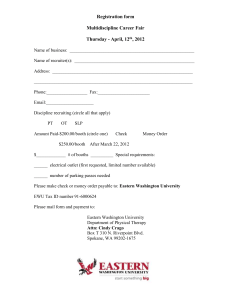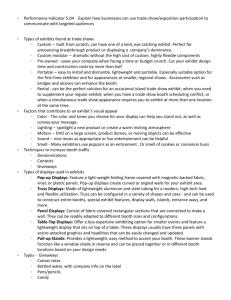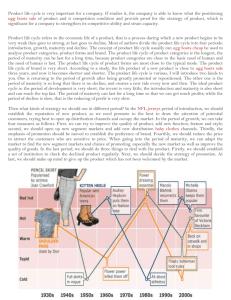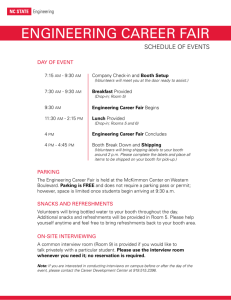Using Trade Shows Throughout the Product Life Cycle
advertisement
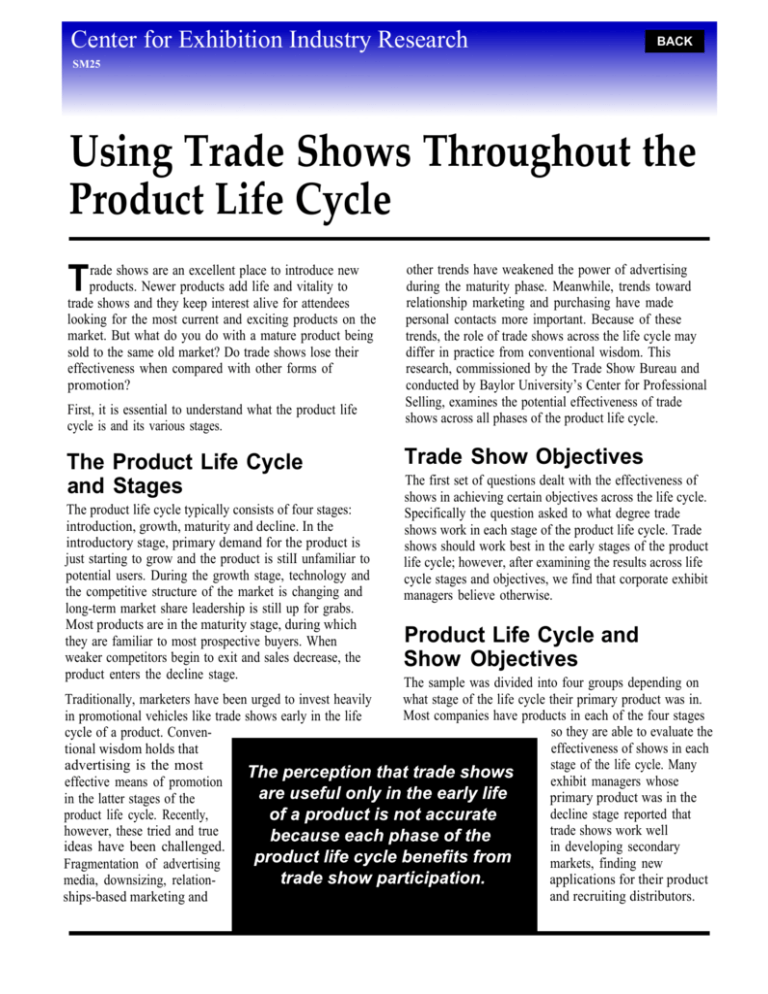
Center for Exhibition Industry Research BACK SM25 Using Trade Shows Throughout the Product Life Cycle T rade shows are an excellent place to introduce new products. Newer products add life and vitality to trade shows and they keep interest alive for attendees looking for the most current and exciting products on the market. But what do you do with a mature product being sold to the same old market? Do trade shows lose their effectiveness when compared with other forms of promotion? First, it is essential to understand what the product life cycle is and its various stages. The Product Life Cycle and Stages The product life cycle typically consists of four stages: introduction, growth, maturity and decline. In the introductory stage, primary demand for the product is just starting to grow and the product is stilI unfamiliar to potential users. During the growth stage, technology and the competitive structure of the market is changing and long-term market share leadership is still up for grabs. Most products are in the maturity stage, during which they are familiar to most prospective buyers. When weaker competitors begin to exit and sales decrease, the product enters the decline stage. Traditionally, marketers have been urged to invest heavily in promotional vehicles like trade shows early in the life cycle of a product. Conventional wisdom holds that advertising is the most effective means of promotion in the latter stages of the product life cycle. Recently, however, these tried and true ideas have been challenged. Fragmentation of advertising media, downsizing, relationships-based marketing and other trends have weakened the power of advertising during the maturity phase. Meanwhile, trends toward relationship marketing and purchasing have made personal contacts more important. Because of these trends, the role of trade shows across the life cycle may differ in practice from conventional wisdom. This research, commissioned by the Trade Show Bureau and conducted by Baylor University’s Center for Professional Selling, examines the potential effectiveness of trade shows across all phases of the product life cycle. Trade Show Objectives The first set of questions dealt with the effectiveness of shows in achieving certain objectives across the life cycle. Specifically the question asked to what degree trade shows work in each stage of the product life cycle. Trade shows should work best in the early stages of the product life cycle; however, after examining the results across life cycle stages and objectives, we find that corporate exhibit managers believe otherwise. Product Life Cycle and Show Objectives The sample was divided into four groups depending on what stage of the life cycle their primary product was in. Most companies have products in each of the four stages so they are able to evaluate the effectiveness of shows in each stage of the life cycle. Many exhibit managers whose primary product was in the decline stage reported that trade shows work well in developing secondary markets, finding new applications for their product and recruiting distributors. They reported that shows did not work well in the decline stage in generating leads and only moderately well for obtaining sales in the decline stage. For all other objectives and stages, their perceptions of show effectiveness were equivalent to exhibit managers whose primary product was in an earlier stage. These results lead us to the conclusion that shows work equally well regardless of what stage a company’s product is in. It appears that trade shows are used primarily in the early stages of the product life cycle as a means of promotion while in the latter stages they are used as selling tools. Yet, even though shows are seen as more effective for generating leads and product awareness in the introductory stage, the importance of trade shows for these purposes should not be restricted to the introduction. Other objectives for exhibiting at trade shows, such as image building and establishing a presence, are shown to be accomplished in all stages of the product life cycle. The perception that trade shows are useful only in the early life of a product is not accurate because each phase of the product life cycle benefits from trade show participation. managers. to first rate the importance of each objective, then indicate the stage of the product life cycle in which the particular measure would be used. The most frequently used show performance measure is the number of qualified leads and the least is the number of freebies given away. The cost per product demonstration was also rated unimportant, a somewhat surprising finding since the number of demonstrations is an important measure of trade show performance. Product Life Cycle and Performance The results tell us that, for the most part, organizations use trade shows to achieve the same objectives regardless of the stage of product life cycle for their primary product. However, two significant differences do exist: Trade Show Performance › Volume of literature passed out is not important in the introduction stage but grows in importance over the life cycle. › Attitude of booth visitors is very important in the introduction stage but declines in importance over the product life cycle. By examining how trade show performance is measured and in which stages those measures are used, we can understand exhibit managers’ perceptions of how trade shows should be used across the product life cycle. Twenty-seven measures of trade show performance were generated by reviewing previous Trade Show Bureau studies and through in-depth interviews with corporate exhibit managers. The survey asked corporate exhibit The top six measures overall are the number of qualified leads, performance of booth personnel, booth traffic, sales obtained, number of customer requests for additional information and attitude of visitors to the booth. Number of qualified leads was the most important objective among users across all stages except decline, in which it was second. Booth traffic was second and third in each stage, and performance of booth personnel was in the top three across all stages. Most corporate exhibit managers reported that their primary product was in the maturity stage, with growth being the second most reported category. Product Life Cycle and Pre-Show Promotion The importance of pre-show promotion varies across the stages of the product life cycle. It is most important in the introductory stage and drops in importance from thereto the growth and maturity stages. Another drop occurs from the maturity to the decline stage. Personal invitations are the most commonly used pre-show promotion. Blanket direct mail, advertising and publicity are used most during the introduction stage. Pre-show promotions are used primarily to announce new products and new programs at the booth during the introduction stage and to invite customers and prospects during the growth and maturity stages. During the decline stage, pre-show promotions are used to announce new programs. These differences may explain the varied media used in pre-show promotions across stages. Booth Staffing Practices Companies whose primary product is in the introduction phase are more likely to staff the booth with marketing personnel (3l% compared to about 20% for all other stages). This finding is consistent with the earlier finding that promotion objectives appeared to be more important in the introduction stage. It is interesting to note that there is a significant increase in sales personnel for ‘ companies in the decline stage, in which nearly 80% of the booth staff are from sales. Lower management is more likely to be employed by companies in the introduction and decline stages (40 and 41% respectively) while middle management generally is involved in the growth and maturity stages (49 and 53% respectively). The companies in the decline stage are most likely to use top management in the booth (32% compared to 18% for the others). OveralI, about 20% of the booth staff is top management, 48% is middle and 32% is lower management. Post-Show Follow-Ups Based on Trade Show Bureau literature and interviews with corporate exhibit managers and marketing executives, eight potential follow-up actions were listed. The primary follow-up technique is a telephone call by the account representative, regardless of life cycle stage. Differences do occur, however, across stages for other follow-up actions. Both tracking leads all the way to the sale and getting feedback on lead quality are used more frequently in the introduction stage. During the decline stage, telemarketing is used most frequently and mailing brochures is rarely used. In a number of instances, the follow-up action was not known by the respondent because it is the function of another department in more cases than not. This is particularly true in the growth and decline stages. Importance and Use of Performance Measures Exhibit managers who feel that a performance measure is important show a much greater tendency to use that measure in evaluating shows than do their counterparts who feel that the performance measure is much less important. This relationship holds true for all stages of the product life cycle. Conclusions Trade Show Bureau research indicates that seeing new products and solutions is a main objective of attendees at trade shows. These results also indicate, however, that trade shows are effective in achieving a wide range of goals across all stages of the product life cycle. This means that factors other than the stage of the product life cycle are more likely to influence trade show success. The primary finding of this study, though, is that trade shows work, no matter what stage the product is in. About the Study Approximately 1750 exhibit managers and 1300 marketing executives were randomly surveyed, resulting in 217 and 250 responses respectively. Subjects were surveyed from six different industries: › Computer/High Tech › Food and Beverage › Gift and Apparel › Hospitality/Service › Medical › Manufacturing Trade Show Bureau gratefully acknowledges the following organizations for providing mailing lists: Healthcare Convention & Exhibitors Association, Food Marketing Institute, Exhibitor Times and Business Marketing. The study was commissioned by the Trade Show Bureau and conducted by Dr. Jeff Tanner and Dr. Larry Chonko of Baylor University’s Center for Professional Selling.

